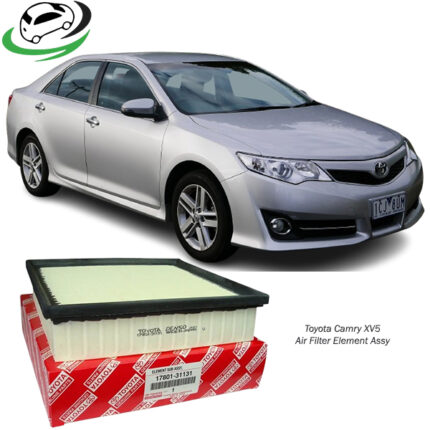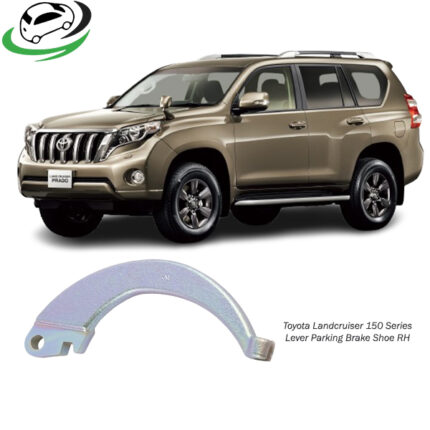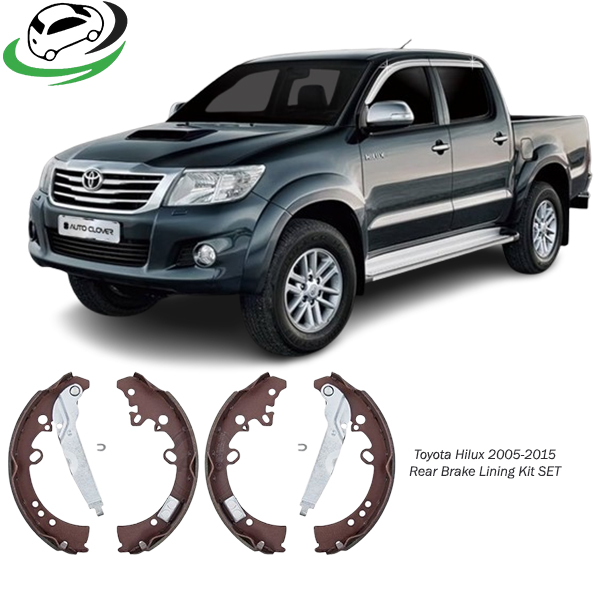-7%
Get Toyota Hilux 2005-2015 Rear Brake Lining Kit Set 044950K120
The rear brake lining kit set is a crucial component of a vehicle’s braking system, responsible for ensuring safe and effective braking performance. The brake lining, often referred to as brake pads in disc brake systems or brake shoes in drum brake systems, is designed to create friction against the brake rotor or drum, enabling the vehicle to slow down or stop effectively. This guide will explore the purpose, components, benefits, installation, maintenance, and signs of wear related to rear brake lining kit sets.
1. Purpose of the Rear Brake Lining Kit Set
The primary purpose of the rear brake lining kit set is to provide the necessary friction to halt the vehicle when the brakes are applied. When the brake pedal is pressed, hydraulic pressure forces the brake pads or shoes against the rotors or drums, converting kinetic energy into thermal energy through friction. This process slows down the wheels, ultimately bringing the vehicle to a stop.
a. Friction Generation
The friction material on the brake linings is specially formulated to provide the right balance between stopping power and wear resistance. It must generate enough friction to stop the vehicle efficiently while also being durable enough to withstand the heat generated during braking.
b. Heat Dissipation
Braking generates significant heat, which can affect the performance of the brake system. The rear brake lining is designed to dissipate this heat effectively, preventing brake fade, which occurs when the brakes lose effectiveness due to overheating.
c. Noise Reduction
Modern brake linings often include noise-dampening features to minimize the squeaking or grinding noises that can occur during braking. This contributes to a quieter and more comfortable driving experience.
2. Components of the Rear Brake Lining Kit Set
A complete rear brake lining kit typically includes several essential components, each contributing to the overall functionality and performance of the braking system. Here are the main components:
a. Brake Linings (Pads or Shoes)
- Brake Pads: In disc brake systems, brake pads are the components that press against the brake rotor to create friction. They typically consist of a metal backing plate with a layer of friction material attached.
- Brake Shoes: In drum brake systems, brake shoes are curved components that press against the inside of the drum to create friction. They are typically made of a metal backing plate with friction material bonded to one side.
b. Backing Plates
The backing plate serves as a structural support for the brake pads or shoes. It provides a surface for attachment to the caliper (in disc brakes) or the brake assembly (in drum brakes) and helps ensure proper alignment and stability during operation.
c. Spring Clips and Retaining Clips
Spring clips and retaining clips are used to secure the brake pads or shoes in place, preventing them from shifting or moving during braking. They also assist in maintaining the proper gap between the brake components.
d. Shims
Shims are often included in brake lining kits to reduce noise and vibration during braking. They create a buffer between the brake pad and the caliper or backing plate, helping to minimize brake squeal.
e. Lubricants
Some kits may include lubricants designed to be applied to specific points during installation. These lubricants help reduce friction between moving parts, preventing sticking and enhancing the overall performance of the brake system.
3. Benefits of a Rear Brake Lining Kit Set
Investing in a quality rear brake lining kit set offers numerous benefits for vehicle performance and safety:
a. Enhanced Stopping Power
High-quality brake linings provide superior friction, ensuring that your vehicle can stop quickly and effectively. This is particularly important in emergency situations where rapid deceleration is required.
b. Increased Durability
Genuine or high-performance brake lining kits are designed to withstand the rigors of everyday driving. They offer improved wear resistance, extending the life of your brake components and reducing the frequency of replacements.
c. Reduced Noise and Vibration
Modern brake linings are engineered with noise-dampening features that minimize brake squeal and vibrations. This contributes to a quieter and more comfortable driving experience, enhancing overall satisfaction.
d. Improved Heat Dissipation
Quality brake linings are designed to dissipate heat effectively, reducing the risk of brake fade during extended or heavy braking. This is especially beneficial for drivers who frequently travel hilly terrain or engage in towing.
e. Safety Assurance
Having a reliable rear brake lining kit set is essential for maintaining vehicle safety. Well-maintained brakes ensure effective stopping power, reducing the risk of accidents caused by brake failure.
4. Installation of the Rear Brake Lining Kit Set
Installing a rear brake lining kit set is a task that can be undertaken by skilled DIY enthusiasts or performed by professional mechanics. Proper installation is crucial for ensuring optimal performance and safety. Here’s a general overview of the installation process:
a. Gather Necessary Tools
Before beginning the installation, gather the required tools, including:
- Jack and jack stands
- Lug wrench
- Socket set
- Torque wrench
- Brake cleaner
- Lubricant (if included in the kit)
- Safety goggles and gloves
b. Prepare the Vehicle
- Lift the Vehicle: Use a jack to lift the rear of the vehicle and secure it on jack stands.
- Remove the Wheel: Use a lug wrench to remove the lug nuts and take off the rear wheel, exposing the brake assembly.
c. Remove Old Brake Linings
- Remove the Brake Caliper (Disc Brakes): If your vehicle has disc brakes, unbolt and remove the brake caliper from the rotor. Be cautious not to damage the brake line.
- Remove Brake Shoes (Drum Brakes): For drum brakes, remove the brake drum and disconnect the brake shoes from the backing plate.
- Clean the Assembly: Use brake cleaner to clean the caliper, rotor, or drum, and inspect for any signs of damage or wear.
d. Install New Brake Linings
- Install the Brake Pads or Shoes: Place the new brake pads or shoes in the correct position, ensuring they are aligned properly.
- Reattach the Caliper (Disc Brakes): If using disc brakes, reattach the brake caliper, ensuring it is secured correctly.
- Reattach the Brake Drum (Drum Brakes): For drum brakes, reattach the brake drum and ensure it spins freely without dragging.
e. Reinstall the Wheel and Lower the Vehicle
- Reinstall the Wheel: Place the wheel back on and hand-tighten the lug nuts.
- Lower the Vehicle: Carefully lower the vehicle off the jack stands using the jack.
- Tighten the Lug Nuts: Use a torque wrench to tighten the lug nuts to the manufacturer’s specifications.
f. Test the Brakes
Before driving, pump the brake pedal several times to ensure proper contact between the brake pads or shoes and the rotors or drums. Test the brakes in a safe area to ensure they are functioning correctly.
5. Maintenance of Rear Brake Lining Kit Set
Regular maintenance is essential for prolonging the life of your rear brake lining kit set and ensuring safe driving conditions. Here are some maintenance tips:
a. Inspect Regularly
Check the condition of the brake linings during routine vehicle inspections. Look for signs of wear, such as thinning or cracking.
b. Listen for Noises
Pay attention to any unusual noises when braking, such as squealing or grinding. These sounds may indicate that the brake linings need replacement.
c. Monitor Brake Performance
Be aware of changes in brake performance, such as increased stopping distances or a spongy brake pedal. If you notice any issues, have the brake system inspected.
d. Replace as Needed
Follow the manufacturer’s recommendations for brake lining replacement intervals. Even if the brake linings appear to be in good condition, they should be replaced at regular intervals to ensure safety and performance.
e. Use Quality Parts
Always choose high-quality or OEM brake lining kits for replacements. Using inferior components can compromise brake performance and safety.
6. Signs of Wear and When to Replace
Understanding the signs of wear is crucial for maintaining brake safety. Here are some common indicators that the rear brake lining kit set may need replacement:
a. Squeaking or Squealing Noises
Persistent squeaking or squealing sounds when applying the brakes may indicate worn brake linings. Most modern brake pads have built-in wear indicators that produce noise when the pads are nearly worn out.
b. Grinding Noises
A grinding noise when braking suggests that the brake linings have worn down completely, and the metal backing plate is making contact with the rotor or drum. This condition can cause significant damage to the braking system and must be addressed immediately.
c. Vibrations or Pulsing
If you feel vibrations or a pulsing sensation in the brake pedal when braking, it may indicate warped rotors or unevenly worn brake linings. This condition can compromise braking performance and should be inspected by a professional.
d. Reduced Stopping Power
A noticeable decrease in braking performance, such as longer stopping distances or difficulty slowing down, may indicate that the brake linings are worn and need replacement.
e. Visual Inspection
Inspect the brake linings for visible signs of wear, such as cracks, thinning, or uneven wear patterns. If the friction material is worn down to the minimum thickness specified by the manufacturer, it’s time for a replacement.
Conclusion
The rear brake lining kit set is an essential component of your vehicle’s braking system, directly impacting safety and performance. By understanding its purpose, components, benefits, and maintenance practices, vehicle owners can ensure their braking system operates optimally. Regular inspections, timely replacements, and using high-quality or OEM parts are crucial for maintaining effective braking performance and ensuring the safety of both the driver and passengers. Always prioritize brake maintenance and replacement to enjoy a safe and smooth driving experience.
Follow us on Facebook for more parts.




Reviews
Clear filtersThere are no reviews yet.